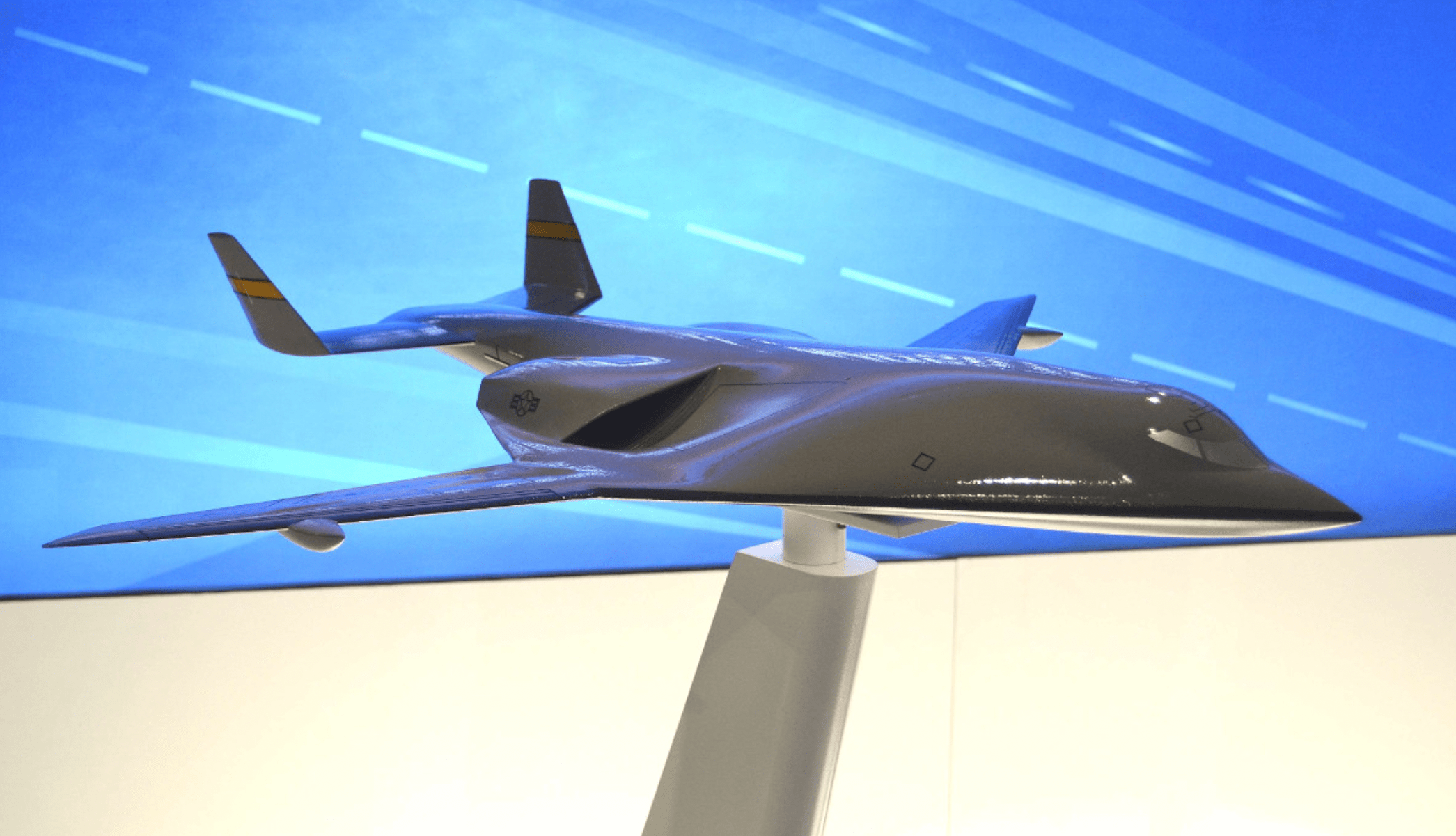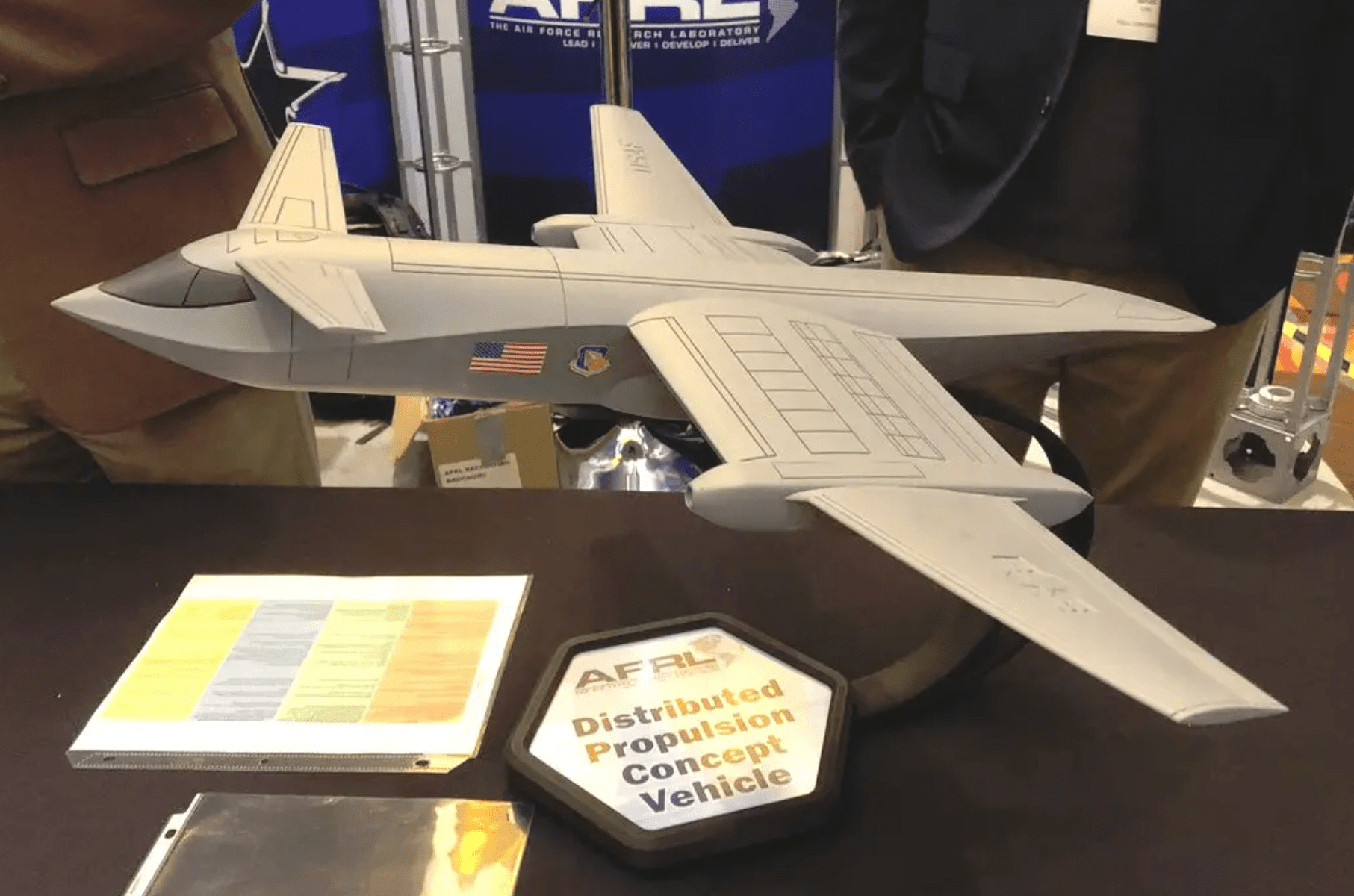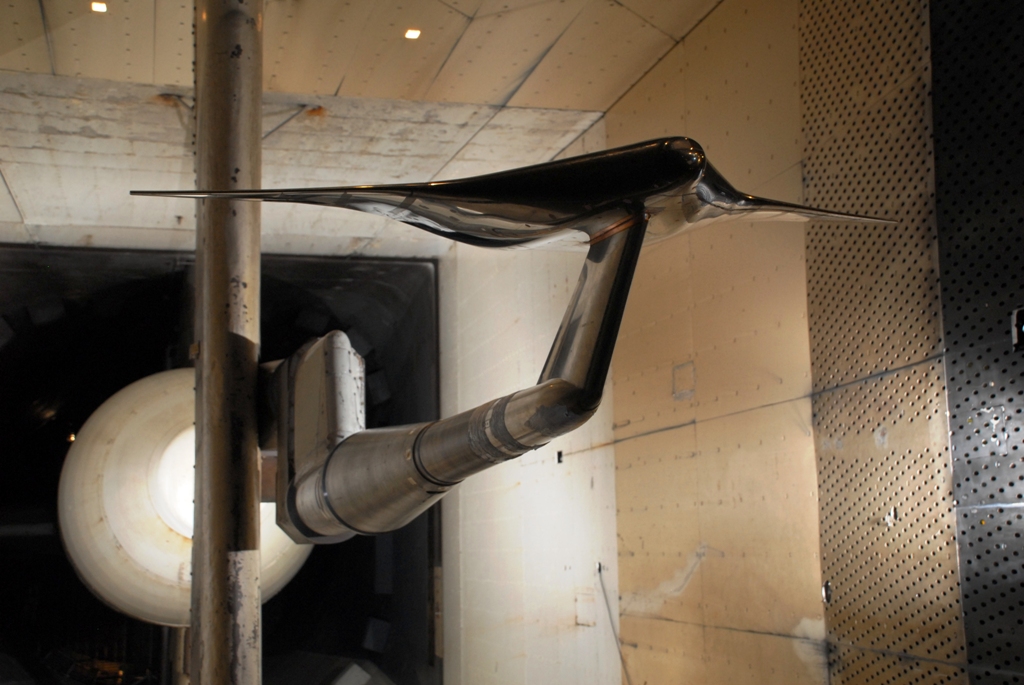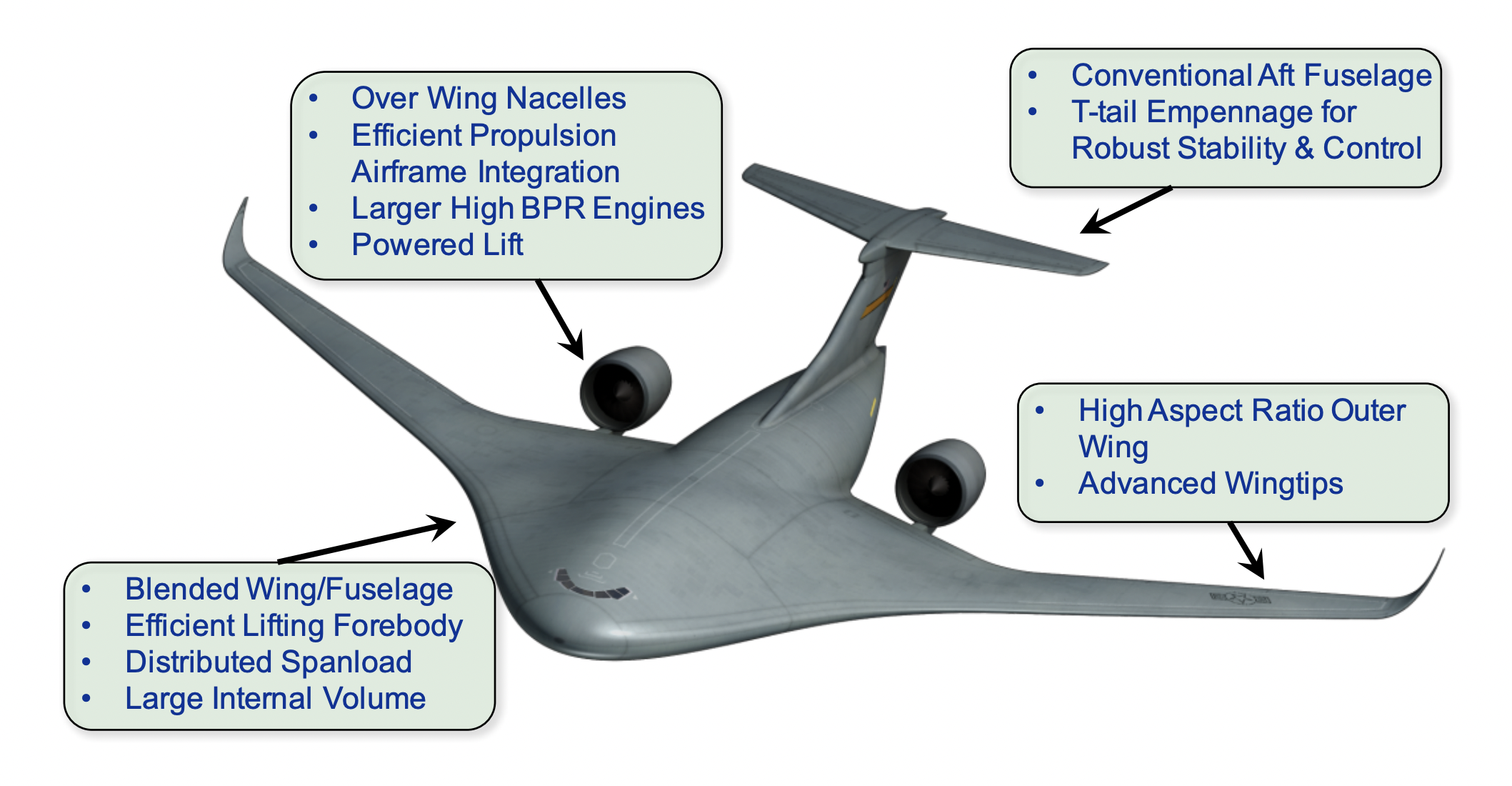The Pentagon is back in the market for blended wing body, or BWB, aircraft designs, with a view toward building a full-size demonstrator aircraft and having it fly by 2026. The latest initiative, which the U.S. Department of Defense will kick off by looking for relevant design concepts for further study, focuses on the efficiency benefits that these configurations can offer. The project could impact future aerial refueling tanker and airlift programs, with the U.S. Air Force already having explored BWB designs, including stealthy types, for these roles in the past.
The request for information (RFI) was recently published on the website of the Defense Innovation Unit, a Pentagon organization set up to help the U.S. military make faster use of emerging commercial technologies. The RFI calls upon commercial companies to provide digital concepts of design (CoD). These should be able to lead to full-scale prototypes of what it describes as an “advanced aircraft configuration that provides at least 30 percent more aerodynamic efficiency than the Boeing 767 and Airbus A330 families of commercial and military aircraft.”

It’s notable that the two airliner types mentioned serve as the basis for the KC-46A Pegasus and A330 Multi-Role Tanker Transport (MRTT) aircraft, respectively, with the former having beaten the latter to the Air Force’s KC-X tanker requirement. Nevertheless, the KC-46 has had a string of problems and delays, leading to operational limitations, and the A330 MRTT remains on offer for a potential follow-on tanker buy.
This might suggest that the BWB aircraft designs DIU expects to study could be considered as tankers for the future KC-Z requirement, which envisages a much more advanced aircraft than the KC-46, perhaps with stealth characteristics.

Ahead of this, there is also the KC-Y, to meet an Air Force requirement for additional tankers to “bridge the gap” between the end of its planned KC-46 purchases and the KC-Z. This could be met by buying more KC-46s on top of the 179 already planned, or switching to the A330 MRTT, which is being marketed by Lockheed Martin as the LMXT.
In April this year, Air Force Chief of Staff Gen. Charles Q. Brown Jr. hinted that a “tweaked” KC-46 could be the best option for KC-Y. This came only a month after Air Force Secretary Frank Kendall had said that “the likelihood of a competition has come down,” in reference to both KC-Y and KC-X.

Speaking to Air Force Magazine, a spokesperson from the Air Force Research Laboratory (AFRL) confirmed that the new DIU RFI “is not connected to the KC-Y program” but declined to say whether it was related in any way to KC-Z.
The RFI assumes that the expected efficiency savings will be achieved through a combination of the BWB aerodynamic configuration and “projected 2030 engine technology,” which will result in “at least 60 percent mission fuel-burn reduction compared to current-day technology.” In this respect, the project recalls the aims of previous efforts that have explored the potential of exotic propulsion systems for high levels of efficiency (and to provide short takeoff capabilities). These include a Distributed Propulsion Concept Vehicle from AFRL that uses gas turbines to produce power for arrays of electric fans.

With these advantages, the aircraft should be able to offer the Air Force greatly increased range, loiter time, and offload capabilities, compared to the cargo aircraft and tankers now in use. For tankers specifically, the ability to offload fuel at a significant range is a key metric, especially in potential Asia Pacific scenarios, and this is an area in which a highly efficient BWB design could excel.

At the same time, these efficiency improvements are intended to target broader goals to reduce the Pentagon’s reliance on fossil fuels. “The Department [of Defense] is presently the largest consumer of petroleum-based energy in the Federal Government, contributing to 77 percent of overall consumption,” the RFI adds. “The majority of that is attributed to fuel for aircraft sorties supporting global operations.”
At this point, growing concerns about the Pentagon’s fuel dependency, and the degree to which it makes the U.S. military vulnerable, are combined with the expectation that future operations and contingencies are likely to be focused on the Asia-Pacific region. The distances involved in this theater will demand longer-range sorties while increasing fuel logistics demands and supply chain risks. Highly efficient transport and tanker aircraft are one way to help address this.
Meanwhile, there are other programs underway that are seeking to demonstrate more efficient transport aircraft technologies. Under a NASA contract announced in August last year, Boeing, Raytheon Technologies, General Electric, Blended Wing Aircraft, and ROHR are supporting the Future Subsonic Demonstrator Risk Reduction Activities program. This is intended to identify technologies for subsonic transport aircraft, including potentially BWB concepts, which meet stringent sustainability, environmental, noise reduction, efficiency, and cost objectives.
Overall, the high priority assigned to the efficiency and sustainability of the requested BWB designs is reflected in the fact that the RFI is sponsored by the Air Force Operational Energy Office, rather than AFRL or the Air Force Life Cycle Management Center (AFLCMC), which would typically be expected to handle these kinds of solicitations.

As well as offering significant aerodynamic efficiencies, the designs called for should also incorporate a modular open system approach, or MOSA, “to allow for system integration and future upgrades.” This may refer to adaptation for the tanker role, or it could also point to plans for the aircraft to undertake other missions in the future, too.
The designs should consider the “incorporation of various mission-specific systems,” with the two examples given being electronic warfare components and notional systems for the Joint All Domain Command & Control (JADC2) architecture. This is in keeping with current plans to turn the KC-135 into a communications hub for other platforms, as well as past statements from Gen. Brown, who has said he wants to see future tankers boasting “additional self-protection” capabilities as well as equipment to serve as a communication node.

In fact, while the new RFI does not mention the tanker role by name, it’s striking how many similarities there are between it and the Advanced Aerial Refueling Family of Systems (AAR FoS) program, launched last month by AFLCMC.
The RFI for AAR FoS scopes out future tankers that will be better optimized for refueling uncrewed aircraft and will also be able to function as electronic warfare platforms.
However, while the Defense Innovation Unit’s solicitation has an exotic BWB design at its core, the AAR FoS is a more evolutionary approach, starting with adding new capabilities to the current tanker fleet (KC-46A and KC-135R/T), before “developing the overall requirements for a new tanker aircraft.”
While different, it’s certainly conceivable that the overlap between the two RFIs means that elements from each could, ultimately, be rolled together to help create new-generation tankers and transports.

In keeping with current design concepts, the RFI stipulates that companies should show that they can use “digital engineering tools and processes to design, develop, test, verify, validate, and certify the system for possible follow-on prototype build, live-fly, and production.” A full-scale demonstrator aircraft would be expected to take to the air by 2026.
Somewhat surprisingly, perhaps, the RFI does not mention a requirement for stealth or low observability. Although, by their nature, BWB designs, with their broadly flying-wing configuration, lend themselves uniquely to overall low-observable design concepts compared to traditional aircraft configurations. At the same time, these kinds of designs offer considerable advantages when it comes to internal space for the carriage of cargo and/or fuel.

It could also be the case that Air Force thinking around KC-Z has seen the requirement for low observability either scaled back or perhaps even dropped entirely. Speaking earlier this year, Gen. Brown noted that he expected the Next Generation Air Dominance (NGAD) combat air system would “the range to go where it needs to go,” reducing the apparent requirement for a stealthy ‘escort’ tanker to accompany it into harm’s way.
There’s also the possibility that the idea of incorporating stealth into a future tanker (or transport) has become a lower priority since the Air Force has begun looking more seriously at the active defense of such aircraft, using purpose-designed drones.
There have been several studies and proposals regarding missile-armed drones that could provide close escort for more vulnerable high-value asset aircraft (HVAA), such as tankers, and the AAR FoS program notably envisages “off-board Autonomous Collaborative Platforms.” These drones would be expected to escort a range of different aircraft, including combat types, also flying other missions including electronic attack and suppression of enemy air defenses, as well as intelligence, surveillance, and reconnaissance (ISR).
Nevertheless, the low-observable qualities of BWB designs have seen them, in the past, being considered for cargo and tanker roles, as well as for transporting special operations forces. Indeed, The War Zone has charted those developments in considerable detail in a two-part feature that you can find here and here.
And, while the latest RFI includes the potential for building a full-scale prototype, there has been a previous effort to test a subscale demonstrator, in the shape of Boeing’s X-48 program, which was first flown back in 2007.

As to the overall practicality of a BWB design as the basis for a future tanker, The War Zone approached Robert S Hopkins III, an Air Force veteran and author who has written extensively about the C-135 family, in particular.
Hopkins sees “no operational reasons why not” to develop a BWB tanker, although he does point to some critical issues that would likely be raised. First, there is the boom-to-receiver ratio which will depend on the overall size of the tanker. Potentially, a BWB platform could be big enough for three booms along a massive wingspan — one central boom for larger aircraft and two outboard to service two fighter-size receivers. “Using AI, this would be easy,” Hopkins contends.
Then there is the perennial issue of tanker numbers. Should the Air Force purchase, for example, 100 BWB aircraft that have to perform “split duty” as tankers and transports, that would fail to adequately address the current tanker shortage. “Tanker demand is overstressed right now with 460 booms (MPRS pods are irrelevant here), so the total tanker buy needs to equal or exceed that number, whatever the airframe looks like,” Hopkins adds.
While the Air Force’s future tanker requirements have been discussed at length in the past and have yielded the notional KC-Y and Z requirements, it’s less clear to what degree the service has begun to think about successors to its heavy-lift cargo fleet, namely the C-5M Galaxy and C-17A Globemaster III.

The Cold War-era C-5 is currently the largest aircraft in the Air Force inventory and brings an unmatched ability to transport very big and heavy cargoes. It has been the subject of a significant upgrade including a re-engining program, producing the latest C-5M variant, and is expected to remain operational into the 2040s. Beyond that date, a capacious but efficient BWB-type design could be an attractive replacement for the Galaxy.
As for the C-17, production of which ended in 2015, with the final examples being exported, the Air Force has not decided on whether to extend the service life of this workhorse airlifter. This aircraft is the first choice for rapidly moving combat forces, including mechanized ones, across long distances to potential battle areas, but also excels at transport in support of peacekeeping and humanitarian missions.

If the Air Force decides against a major modernization of the C-17, perhaps bearing in mind the increasingly contested airspace in which it might be expected to operate in the future, then a stealthier BWB airlifter might also be considered as a replacement for this.
Beyond the obvious military applications of a BWB design, the RFI also includes reference to a Dual-Use Commercialization Plan, in which thought would be given to potential commercial use. With a combination of long-range, efficiency, and the ability to transport considerable loads, such an aircraft could find use moving civilian cargo loads or passengers. For some years, major airlines have been looking at the potential advantages of BWB configurations and flying-wing-type designs.

Clearly, a BWB aircraft could provide many advantages applicable to both military and commercial operators. With the responses to the RFI due by August 2, we will hopefully find out more, in due course, about the particular missions that the Air Force might have in mind for future blended wing body aircraft and how they might fit into its future modernization plans.
Contact the author: thomas@thedrive.com
